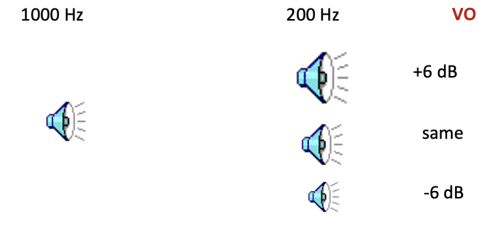Lecture 11- Nature of sound, sound sensitivity, and loudness
1/34
There's no tags or description
Looks like no tags are added yet.
Name | Mastery | Learn | Test | Matching | Spaced |
|---|
No study sessions yet.
35 Terms
Why is the ability to hear events we can’t see so important?
Important signalling function for both animals and humans
E.g. the rustle of leaves or the snap of a twig may signal the approach of a predator
Or for humans, a smoke alarm or ambulance
What is the physical definition of sound?
Sound is pressure changes in the air or other medium
What is the perceptual definition of sound?
Sound is the experience we have when we hear
What is wavelength?
The distance between one peak and the next
What is frequency?
Frequency is the number of pressure cycles per second at a point in space (Hz)
Number of times the waves go up and down per second
In the context of a loudspeaker, what is compression?
When the diaphragm of the speaker moves out, it pushes the surrounding air molecules together
In the context of a loudspeaker, what is refraction?
When the speaker diaphragm moves back in, air molecules spread out to fill the increased space
How does compression and refraction processes produce a sound wave?
This process is repeated hundreds or thousands of times a second, creating a pattern of alternating high and low pressure regions in the air (sound wave)
How do sound waves compare with light waves?
Sound transmission from place to place can cause discernible delays
The perception of different frequencies is much more significant for hearing
For sound, wavelength is on a human scale (unlike light)
Smaller range for light as well
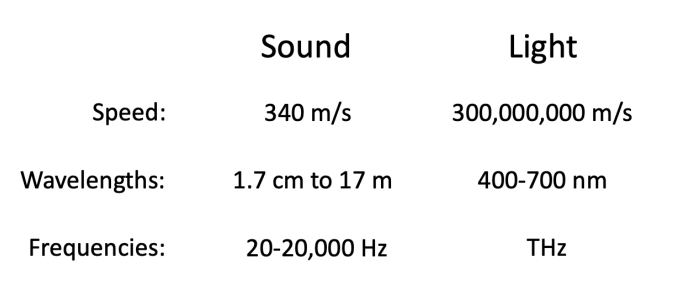
What are pure tones?
Occurs when changes in air pressure occur in a pattern described by a mathematical function called a sine wave
Occasionally found in the environment (e.g. tuning forks), but are primarily generated by computers for lab studies
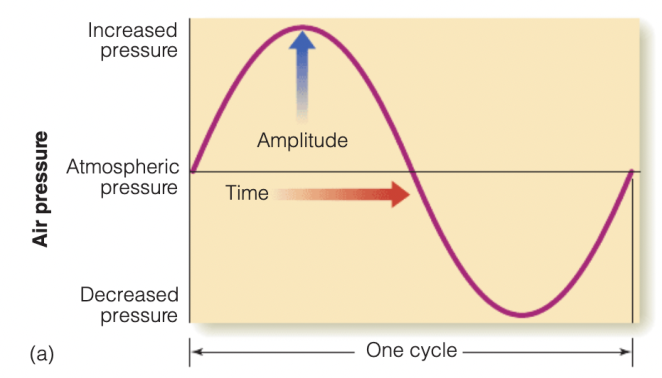
Sound frequency- higher frequencies are associated with the perception of….?
Higher pitches
Frequency is the number of cycles per second that the change in pressure repeats
Measured in Hertz (Hz)
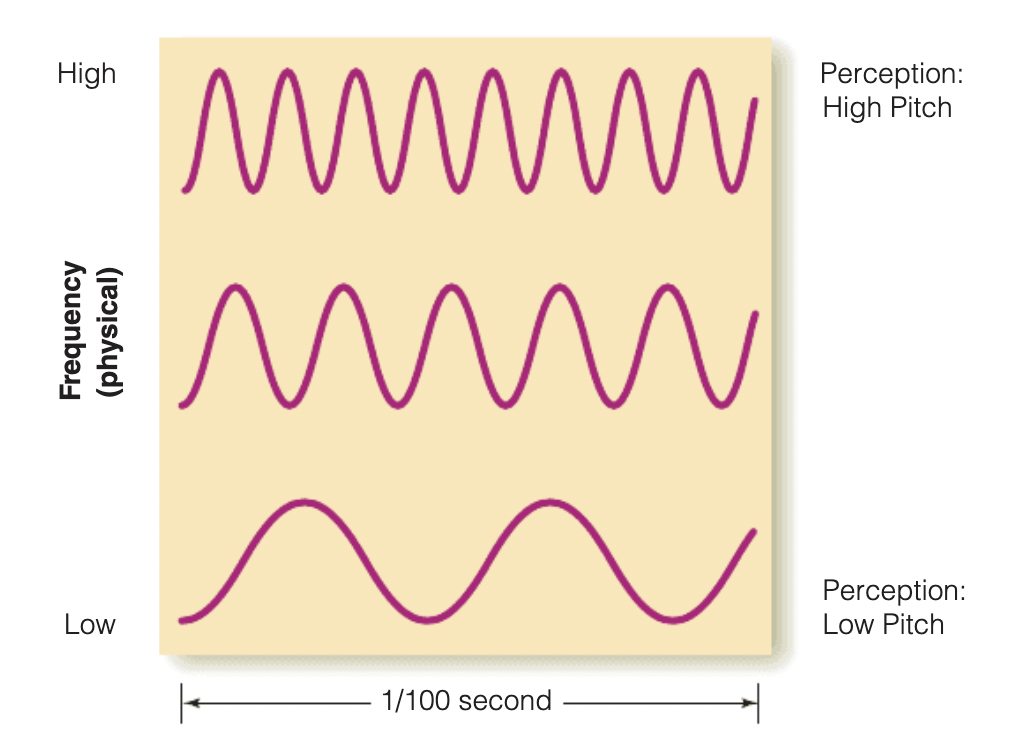
Sound amplitude- large amplitude is associated with the perception of…?
Greater loudness
Amplitude is the difference in pressure between the high and low peaks of the sound wave
Measured in decibels (dB), which converts the large range of sound pressures into a more manageable scale
Pressure measured in Pascals
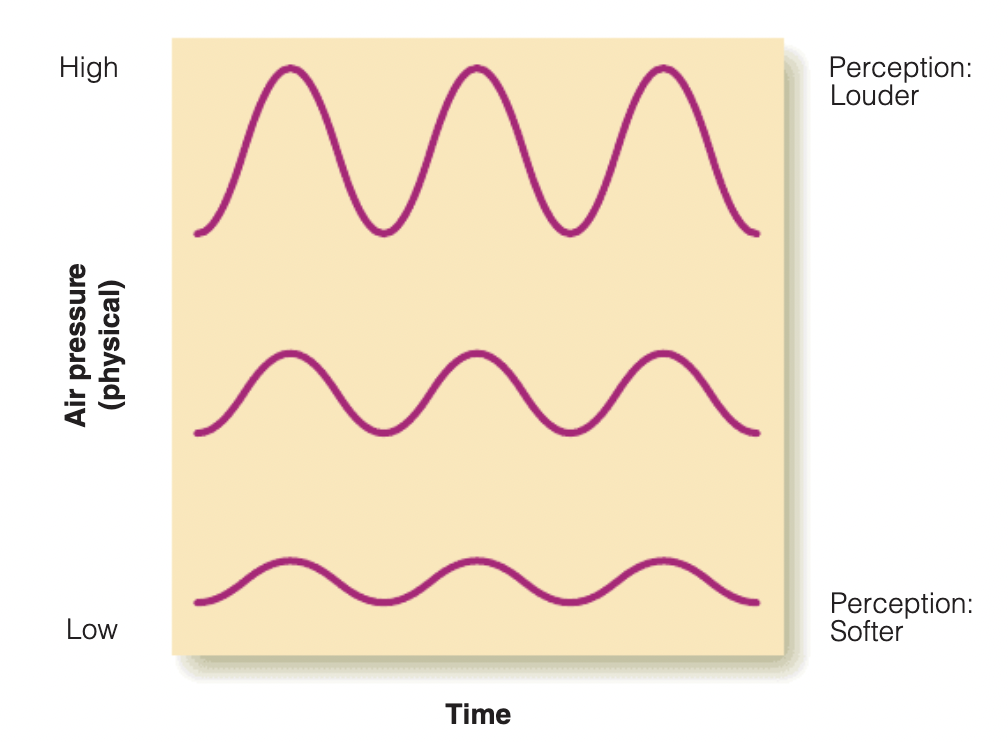
Pure tones are important because they are __ but they are __?
The fundamental building blocks of sounds, rare in the environment
What are complex tones?
The combined waveforms (‘periodic’- repeat themselves)
Wave forms can 'add up' (join each other)
Auditory system can hear these things simultaneously
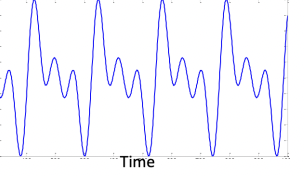
What is the fundamental frequency of the tone?
The rate of repetition
What is a harmonic series?
Higher harmonics; pure tones with frequencies that are whole number (2, 3, 4 etc.) multiples of the fundamental frequency
What musical instruments are based on
E.g. 200, 400 and 600 Hz are all factors of 200
As you go up in frequency, the sine-waves get…?
Fainter (typical of all sound)
What are thresholds in sound?
The smallest amount of sound energy that can just barely be detected
What is loudness in sound? What is loudness associated with?
The perceived intensity of a sound that ranges from 'just audible' to 'very loud'
Decibels are associated with loudness
The relationship between decibels and loudness (physical and perceptual) was determined by S.S Stevens
Used a magnitude estimation procedure
What is the standard pressure level (SPL)?
The faintest sound you can hear at 1 kHz is a fluctuation of about 20 micro-pascals
This value is used as the definition of 0 decibels (dB)- the SPL
Decibel scale is a log scale (more simple to work with)
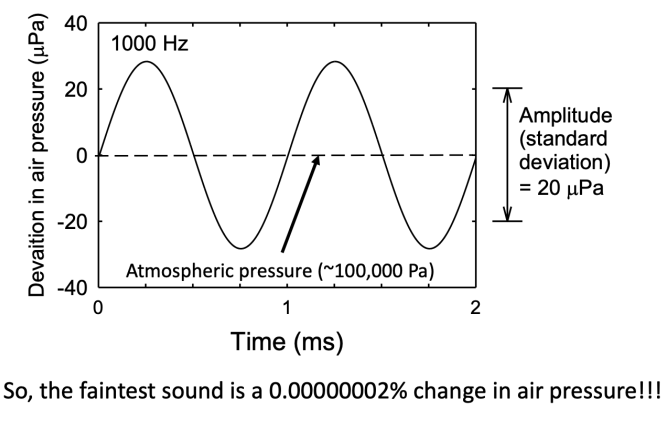
Thresholds and loudness also depend on…?
Frequency (audibility curve)
We can only hear within a specific range of frequencies
Some frequencies have low thresholds (it takes very little sound pressure change to hear them) and others have high thresholds
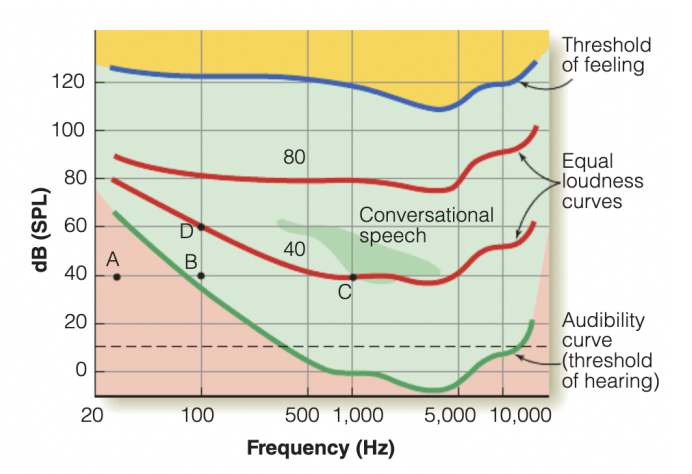
What are the thresholds of feeling and hearing?
Each frequency has a threshold or 'baseline'
The decibels at which is can just barely be heard
Loudness increases as we increase the level above this baseline
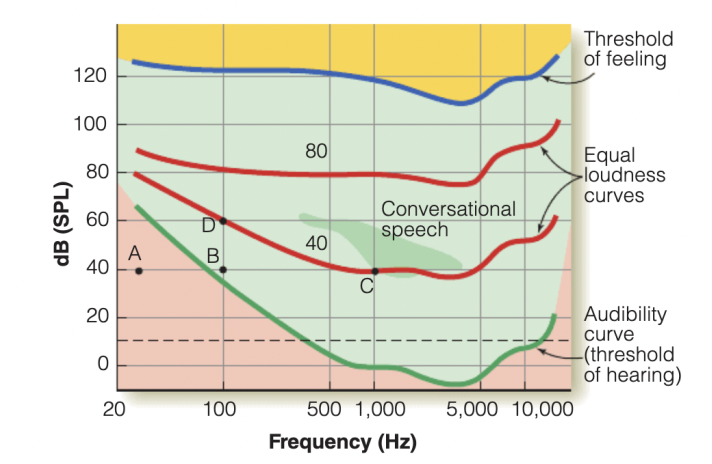
Where does hearing occur?
Hearing occurs in the light green area between the audibility curve (threshold of hearing) and the upper curve (threshold of feeling)
Tones in the red area cannot be heard and tones in the yellow will result in pain
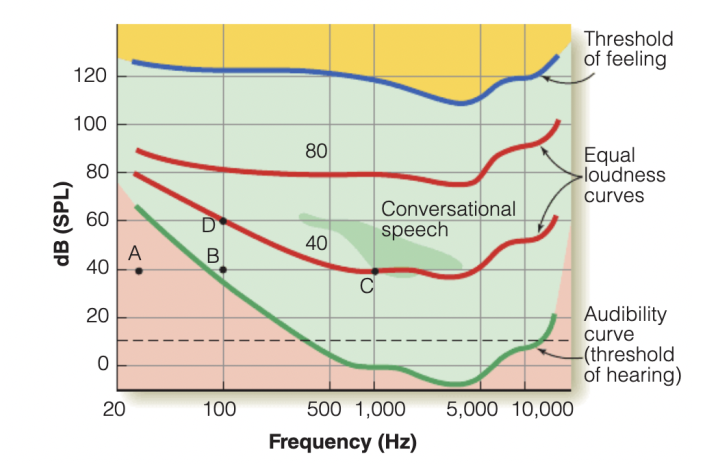
What are the ‘equal loudness curves’?
These curves indicate the sound levels that create the same perception of loudness at different frequencies
Determined by presenting a standard pure tone of one frequency and level and having a listener adjust the level of pure tones with frequencies across the range of hearing to match the loudness of the standard
Detecting low frequencies- in mammals, this is usually to do with…?
How big the mammal is (e.g. elephants are much bigger, can detect really low frequencies)

Detecting high frequencies- which animals have developed really high frequency hearing? Why?
Some insects
To protect themselves from bats
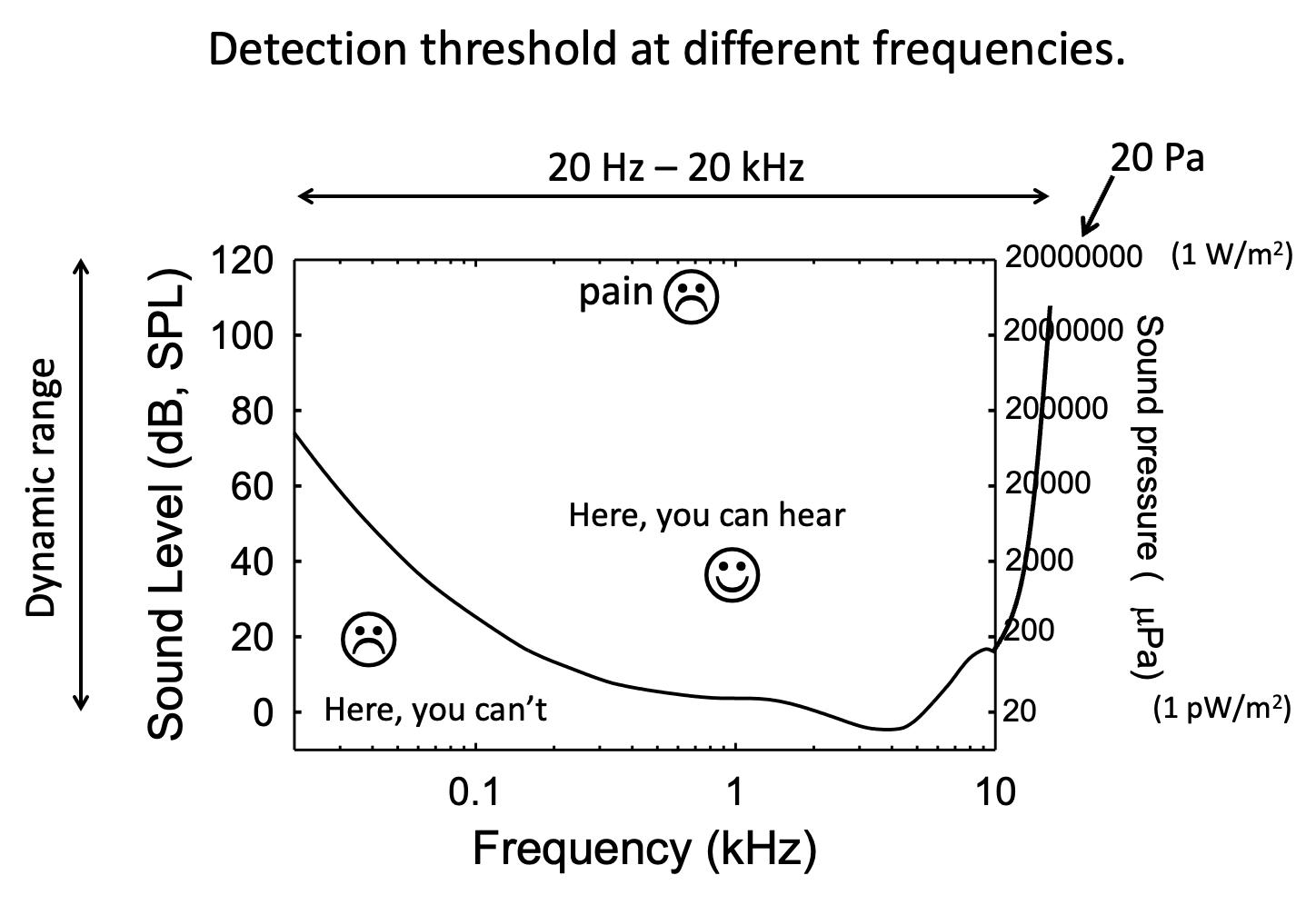
What does this figure show?
As you go down in frequency, you become less sensitive to the sound
Faintest sound you can hear is 20 micro-pascals (0 dB- SPL)
20 pascals is deafeningly loud (120 dB- SPL)
Dynamic range- the range between the faintest and most intense sound
People speaking could go up to about __ dB, it depends on __?
85, the background noise
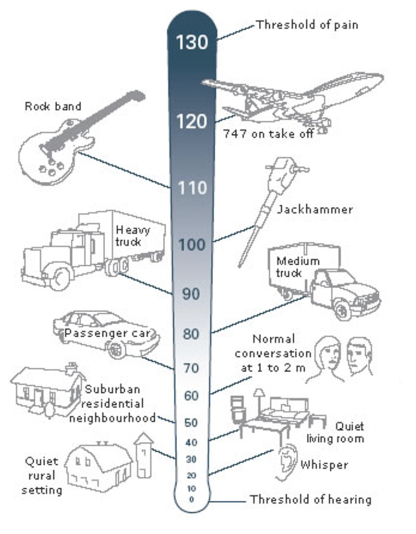
Loudness does not increase in proportion with either…?
Sound amplitude or intensity
This is one reason why sound engineers invented decibels
In decibels a ten-fold increase is 10 dB and a hundred-fold increase is 20 dB etc.
Why are decibels still not quite right?
Because a 10 dB increase is about a doubling of loudness, rather than an increment
Although an increase of 3 dB represents a doubling of the sound pressure, an increase of about 10 dB is required before the sound subjectively appears to be twice as loud
Describe the procedure of a magnitude estimation of loudness experiment (Stevens, 1971)
Give them a standard sound, and a value to attach to that
Play them another sound, ask 'if that sound was 100, what is this?'
Find people give relatively similar answers
How people ascertained that we don't perceive loudness in a linear fashion
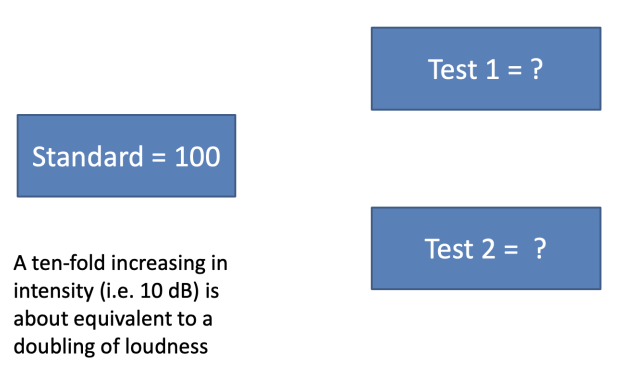
What did Hartmann (1993) do in their magnitude estimation of loudness experiment?
Listener assigns numbers to the loudness of each sound (a broadband noise) which varies in level, compared to a reference sound with the value of ‘100’
Presented lots of tones at the same frequency but different intensities
In a random order
To an audience
Had them write down numbers
What did Hartmann (1993) find in their magnitude estimation of loudness experiment?
People’s estimates are all relatively similar
When you get older, you lose the higher frequency end of your hearing
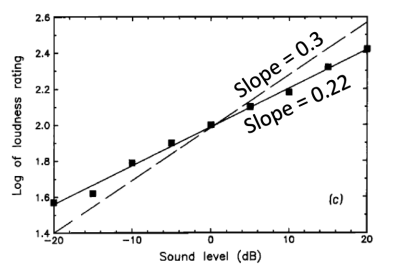
What is an equal-loudness judgement?
Do sounds of the same pressure level but different frequencies have the same loudness?
First play a sound at full volume
Then with the volume down
What is found in equal-loudness judgement studies?
Full volume -> 1kHz matches in volume to the 'same' one
Lowered volume-> 1kHz matches in volume to the '+6 dB' one
